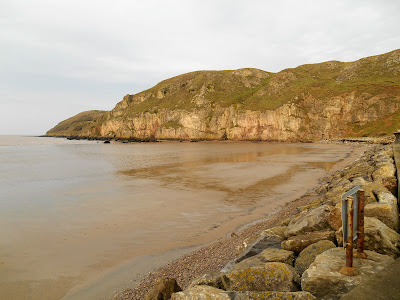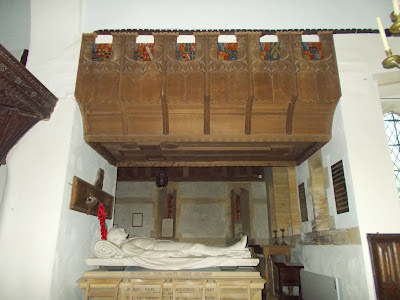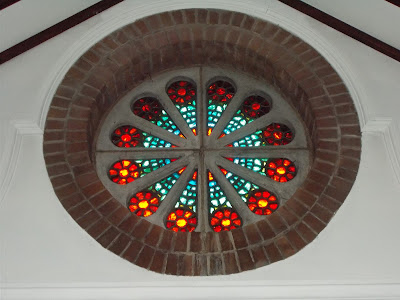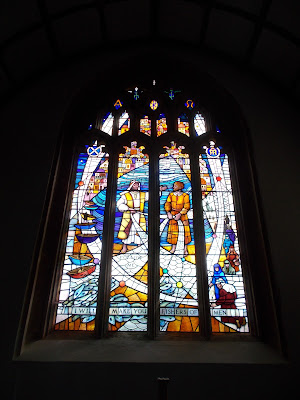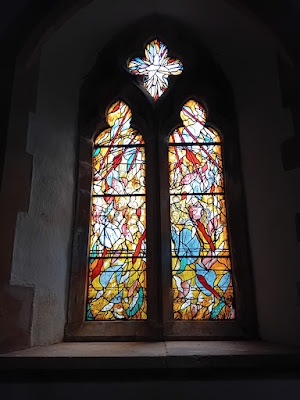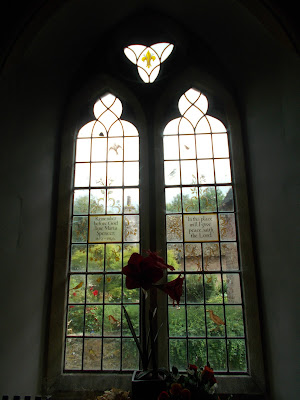Most parish churches in Somerset have some stained glass windows, many of which depict scenes from the Bible and are centuries old. However this blog post is dedicated to modern stained glass windows, which are located mainly in churches but occasionally elsewhere e.g. village halls. Modern stained glass windows are usually light and bright. Many of them were given in memory of people.
St Mary's Church, Luxborough
I presume this is a millennium window, as it has the date 2000 on it. It also says "All generations shall call me blessed.", which is what Mary, the mother of Jesus is quoted as saying in Luke Ch1 v48.
Priddy
This window in St Lawrence's Church, was given in memory of Catherine Gibbons of Eastwater Farm who died on 6th October 1988 aged 19 years.
East Window, St Peter and St Paul's Church, Odcombe
This window is in memory of a Christian writer and missionary called Constance Padwick, who died in 1968. The artist who created the window was apparently Christine Arnatt.
Good Shepherd Window, St Peter and St Paul's Church, Odcombe
In the bottom right hand corner of the window it says simply "Feed my sheep", which Jesus is quoted as saying in John Ch21 v17.
Church of the Blessed Virgin Mary, Cheddon Fitzpaine
St John the Baptist Church, Biddisham
On this window it says "Of his kingdom there shall be no end". This is a quotation from the Gospel of Luke Ch1 v33. The window was made by Gilroy, Bristol Stained Glass in 2000, which presumably makes it a millennium window.
Kingfisher window in All Saints Church, Lopen Church
Wheddon Cross Village Hall
The red band around the central picture contains a quotation from Samuel Taylor Coleridge's poem Frost at Midnight. It says "Therefore all seasons shall be sweet to thee". The window depicts plants and wild and domesticated animals that are found on Exmoor e.g. Exmoor ponies, red deer, buzzards, foxes, sheep and owls.
Daffodils or maybe sunflowers? at St Nicholas' Church, Porlock Weir (a tin tabernacle)
St Andrew's Church, Mells
This window is in memory of Sir John Francis Fortescue Horner, "who worshipped God in this chapel through all the years of his life. Unto whom God gave a wise and understanding heart. Behold such a man as this entered in to the inheritance of peace and quietness". Sir John Horner (1842-1927) was a barrister and he lived in Mells Manor. The window was designed by Sir William Nicholson and depicts St Francis of Assisi preaching to the fish and birds.
Church of St Mary and St Andrew, Pitminster
"I will make you fishers of men" Matthew Ch.4 v.19
Church of St Nicholas, Corfe
St John the Baptist Church, Ashbrittle
Church of St John the Baptist, Frome
In 1990 stained glass artist, Mark Angus was commissioned to make a stained-glass window of a historical timeline commemorating important events in Britain since 597. The events illustrated are from bottom to top:
597 St Augustine lands in Kent
685 St Aldhelm establishes the first church in Frome (the town is depicted with as a red heart with the River Frome running through it).
1066 Norman Conquest of Britain
1349 The Black Death
1536 Dissolution of the Monasteries by Henry VIII
1914-1918 First World War
1939-1945 Second World War
1945 The Atom Bomb (mushroom cloud)
1985 After 1300 years St Aldhelm's Church is still shining the light of the Gospel
It was manufactured by Derix Studios in London and Taunusstein in Germany. It is stunning.
Wildlife triptych, St Mary Magdalene's Church, Winsford
Winsford
Winsford
Daffodil window in Luccombe Church
Millennium Window, St Andrew's Church, Old Cleeve This window was commissioned by the Parochial Church Council to mark the Millennium. It was designed and made by local artist Frankie Pollak. It features an eclipse of the sun, ammonites, the churchyard pink sweet pea and the nets and fish of St Andrew.
Saint Roch with his dog at his feet, Pendomer Church
Tree of Life window at St Roch's Church, Pendomer
Millennium Window, St Martin's Church, Worle
It features a dove of peace.
Millennium Window
St Peter & St Paul's Church, South Petherton
Bellringers' WindowSt Peter & St Paul's Church, South Petherton
This window is dedicated to all the bellringers in the parish, past and present. It was given by Reg Beale in memory of his parents Reginald Beale (1907-1988) and Phyllis Beale (1912-2004) and was unveiled in 2012.
Millennium Window, St Mary's Church, Stoke St Mary
The window was commissioned by Stoke St Mary Church Committee and Stoke St Mary Millennium Committee and was dedicated on 10th September 2000. It was made by Patrick Reyntiens (1925-2021), a leading British stained glass artist, who moved to Somerset in 1982. The window depicts the story of St Anne and her husband St Joachim, teaching the Virgin Mary to read. It was chosen because the window formed part of St Anne's Chapel. St Anne and Mary are linked by a scroll on which the following verse from Isaiah Ch9 v6 is written in Hebrew: For unto us a child is born, unto us a son is given.
The Queen's Golden Jubilee Window, St Mary's Church, Stoke St Mary
This window was also designed and made by Patrick Reyntiens and was installed in July 2003. It depicts the Day of Pentecost, as recorded in Acts Ch2 v2-4: Suddenly a sound like the blowing of a violent wind came from heaven and filled the whole house where they were sitting. They saw what seemed to be tongues of fire that separated and came to rest on each of them. All of them were filled with the Holy Spirit and began to speak in other tongues as the Spirit enabled them.
The Queen's Golden Jubilee Window, St Mary's Church, Stoke St MaryThis window was also designed and made by Patrick Reyntiens and installed in July 2003. It depicts the Annunciation as recorded in Luke Ch1 v26-33: God sent the angel Gabriel to Nazareth, a town in Galilee, to a virgin pledged to be married to a man named Joseph, a descendant of David. The virgin’s name was Mary. The angel went to her and said, “Greetings, you who are highly favoured! The Lord is with you. Mary was greatly troubled at his words and wondered what kind of greeting this might be. But the angel said to her, “Do not be afraid, Mary; you have found favour with God. You will conceive and give birth to a son, and you are to call him Jesus. He will be great and will be called the Son of the Most High. The Lord God will give him the throne of his father David, and he will reign over Jacob’s descendants forever; his kingdom will never end."
Ilminster Grammar School Window, The Minster, Ilminster
This window in the Lady Chapel commemorates Ilminster Grammar School, which was open in Ilminster from 1548-1971. It incorporates the motto from the school's crest: Ingredere ut proficias (which means Enter in order to progress) and the coat of arms of the Old Ilminsterians Association. It was commissioned by former pupils of the school to celebrate the 75th anniversary of the association and was designed by John Reyntiens. The green plant in the central lancet window represents growth towards eternity. The blue triangles on the right and left hand lancet windows represent the water needed for growth. The blue, white and gold triangles remind us of the Holy Trinity. Ilminster Grammar School nurtured and educated the children of Ilminster for more than 400 years. The window was dedicated on 14th July 2007 by the Right Reverend Peter Maurice, Bishop of Taunton.
St Michael & All Angels' Church in Haselbury Plucknett has a quartet of stunning stained glass windows, which were made in the 1980s by two amateur craftworkers, who attended the church (John Banks and Margaret Wiles). They were designed by Margaret Wiles and financed by local families and public contributions. The general theme is light. The windows portray the birth of Jesus, the Transfiguration, the Resurrection and the Day of Pentecost. The windows were dedicated in 1989 by the Suffragan Bishop of Taunton.
Birth of Jesus, Haselbury Plucknett Church
This window is dedicated to the Hunter family of North Carolina.
The Transfiguration of Jesus
This window is in memory of the Pitt family.
The Resurrection of Jesus
The Day of Pentecost
Jane Maria Spencer's (1872-1946) Memorial window in St Peter's Church, Williton
This window has 4 birds painted on it, including a curlew, robin and great tit.
Curlew
Robin and Great tit

